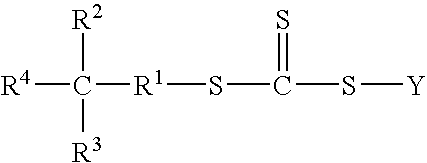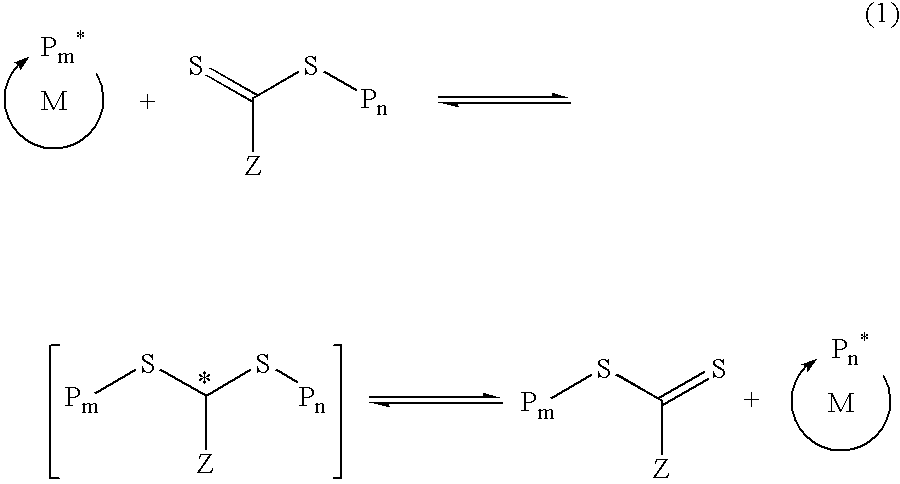Functional trithiocarbonate RAFT agents
- Summary
- Abstract
- Description
- Claims
- Application Information
AI Technical Summary
Benefits of technology
Problems solved by technology
Method used
Image
Examples
example 1
Synthesis of S-Benzyl-S′-(2-hydroxydecyl)trithiocarbonate
(BHDTTC)
[0084]A one liter three neck round bottomed flask equipped with a mechanical paddle stirrer, nitrogen inlet, pot thermometer and condenser, was charged under a slow nitrogen bleed with 95 g (˜0.50 moles) of β-hydroxydecanethiol (HDT). To the stirred HDT, was then added an aqueous solution of 32.0 g of 87.6 percent pure KOH (˜0.50 moles) dissolved in 248 g of water. After stirring for 15 min. at ambient temperature, a solution of 78 g (˜1.0 mole) of carbon disulfide and 1.0 g of Aliquat 336 were added to the mixture. The solution rapidly turns yellow and a small amount of solid precipitated from solution. The solution temperature increased to about 44° C. and was controlled using slight cooling from a water bath. After 15 min., 60.1 g (0.0475 moles) of benzyl chloride were added. Again the temperature was maintained at about 44° C. until the exotherm subsided. At this point, the mixture was heated for one hour at 50° C....
example 2
Synthesis of S-Benzyl-S′-dodecyl trithiocarbonate
(BDTTC)
[0085]Procedure is identical to that of Ex. 1 except that 1-dodecanethiol was substituted for HDT. Crude product crystallizes into a bright yellow solid within a few hours at room temperature.
example 3
Synthesis of S-Benzyl-S′-(11-undecanoic acid)trithiocarbonate
(BUTTC)
[0086]A 500 ml three-necked round bottomed flask equipped with a mechanical paddle stirrer, nitrogen inlet, pot thermometer and condenser was charged under a slow nitrogen purge with 21.8 g (˜0.10 moles) of 11-mercaptoundecanoic acid (I), 12.8 g (˜0.20 moles) of 87.5 percent pure KOH and 100 ml of water. The mixture was stirred and warmed to 50° C. until all of (I) had dissolved and a clear solution was achieved. The solution was then cooled to ˜30° C. before adding all at once a solution of 0.2 g of Aliquat 336 dissolved in 7.6 g (˜0.10 moles) of carbon disulfide. An orange solution develops immediately and the solution temperature increases to ˜45° C. within 10–15 min. After an additional 15 minutes, 12.02 g (˜0.095 moles) of benzyl chloride. A slight temperature increase as the reaction proceeds and the mixture became very thick. After 10 min., an additional 100 ml of water was added to thin the mixture. After st...
PUM
 Login to View More
Login to View More Abstract
Description
Claims
Application Information
 Login to View More
Login to View More - R&D
- Intellectual Property
- Life Sciences
- Materials
- Tech Scout
- Unparalleled Data Quality
- Higher Quality Content
- 60% Fewer Hallucinations
Browse by: Latest US Patents, China's latest patents, Technical Efficacy Thesaurus, Application Domain, Technology Topic, Popular Technical Reports.
© 2025 PatSnap. All rights reserved.Legal|Privacy policy|Modern Slavery Act Transparency Statement|Sitemap|About US| Contact US: help@patsnap.com



